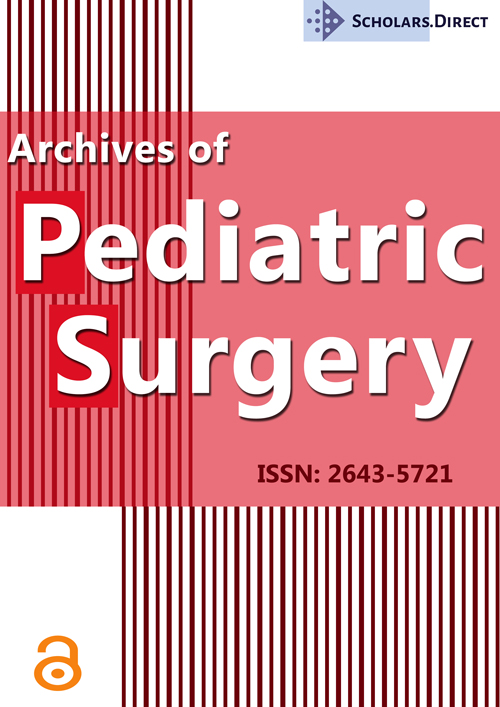Disorders of Sexual Development in Dakar: Epidemiologic and Diagnostic Aspects about 122 Cases
Summary
Introduction: Disorders of sexual development (DSD), also known as variations of sex differentiation, are rare congenital anomalies of sexual development. Managing these conditions poses numerous challenges. The aim of this study was to evaluate the epidemiological and diagnostic aspects of DSD in our practice.
Patients and methods: We conducted a descriptive retrospective study on patients followed and managed for DSD at the pediatric surgery department of the National Children's Hospital Albert Royer over a period of seven and a half years, from July 1, 2016, to December 31, 2023.
Results: We collected 122 cases of DSD during the study period, with a hospital frequency of 16 cases per year. The anomaly was discovered in the neonatal period in 91% of cases. The mean age at first consultation was 3.5 years (1 day-16 years). Signs of puberty in the opposite sex to the rearing sex were noted in three patients (2.5%). Karyotyping revealed 46,XX in 67.7% of cases, 46,XY in 29% of cases, 46,XX/46,XY in 2.5% of cases, 45,XO/46,XX and 45,XO/46,XY in 0.8% each. Subjects with 46,XX were mostly classified as Prader type III, and all subjects with 46,XY presented with hypomasculinization with a mean score of 10.5. Surgical exploration with or without gonadal biopsy was performed in 28 patients (32.2%). The etiology was dominated by congenital adrenal hyperplasia (CAH) found in 31.2% of cases followed by ovotestis in 18% of cases. In a quarter of children, no cause was found. Cloacal malformation was associated in two patients.
Conclusion: DSD are not uncommon and are often diagnosed late in our setting. Congenital adrenal hyperplasia and ovotesticular gonads are the main etiologies.
Keywords
DSD, Child, Karyotyping, Congenital adrenal hyperplasia, Ovotestis
Introduction
Variations in sex differentiation, or Disorders of Sex Development (DSD), are rare congenital anomalies of sexual development resulting in discordance between internal genitalia, external genitalia, and secondary sexual characteristics [1]. Clear estimates of the incidence rate of individuals with sexual differentiation anomalies are lacking. This rate can vary from 1 in 4500 to 1 in 5500 live births in European countries [1-4]. In Africa, an incidence of 28 per 10,000 and 1 in 4500 births has been found in some regions [2,5]. The frequency of DSD also varies depending on the definition and appears to be more common in individuals with 46,XX or 46,XY chromosomes according to different studies [3]. However, this condition seems to be more frequent in areas where consanguineous marriage still exists, notably in Senegal. This partly justifies the frequency of congenital adrenal hyperplasia as the main cause of DSD in most studies [3,5]. DSD are increasingly explored, their pathogenesis better understood, and their management better codified. However, they retain their diagnostic complexity, especially in etiological research for practitioners, constituting a significant burden for children and their families. The aim of this study is to evaluate the epidemiological and diagnostic aspects of DSD in a pediatric surgery department with limited resources.
Patients and Methods
We conducted a retrospective descriptive study over a period of 7 years and 6 months, from July 2016 to December 2023, at the pediatric surgery department of Albert Royer Children's Hospital in Dakar, Senegal. We included all patients seen and managed for DSD who had undergone at least a basic assessment. During the study period, 138 medical records were collected, of which 122 met our selection criteria. We studied the frequency of DSD, age at first consultation, rearing sex, circumstances of anomaly discovery, phenotype, Prader clinical classification, external masculinization score, associated malformations, genetic sex, etiological assessment, and etiologies based on karyotype.
Results
Over the seven and a half years of our study, 122 patients presented with a sexual differentiation anomaly, representing 16 cases per year, accounting for 0.21% of all consultations and 1.04% of hospitalized patients during the study period. In 111 children (91%), the anomaly was discovered in the neonatal period. The mean age of patients at the time of the first consultation was 3.5 years, ranging from 1 day to 16 years. Fifteen patients were newborns, accounting for 12.6% of cases, and 27 patients (22%) were over 3-years-old. Additionally, 15 patients were aged between 11 and 16 years at the time of the first consultation (12.6% of cases). Among them, three had signs of puberty in the opposite sex to their rearing sex. Figure 1 illustrates the different age groups at consultation. In our study population, the rearing sex was female in 63 children (51.64%) and male in 55 children (45.08%). A mixed rearing sex was noted in four patients, accounting for 3.3% of cases. In our series, the anomaly was identified by biological parents in 77 children, representing 63.11% of cases, and by another family member in 9.83% (12 cases). In 27.05% (33 cases), the observation was made by medical or paramedical personnel in the delivery room or during postnatal consultations. The reason for consultation was an anomaly of external genitalia in 115 patients, accounting for 94.26% of cases. One-third of the children had an "ambiguous" phenotype, and nearly a quarter of those with 46XY had a female phenotype. Table 1 illustrates the phenotype of patients based on karyotype.
After a complete clinical examination of the external genitalia, we assessed the degree of virilization in 46XX patients according to the Prader classification. Type 3 accounted for 56% of cases. Details of this classification are provided in Table 2. Hypomasculinization was noted in all our XY patients, with a score below 12. The average score obtained was 10.5, ranging from 1.5 to 10.5. Associated malformations included cloacal malformation in two patients (1.6%), one with a 46XX karyotype and the other with 46XX/46XY chimerism.
The patients were categorized based on the genetic sex obtained after karyotyping into four groups: 46,XX DSD, 46,XY DSD, 45X0 Mosaic, and 46,XX/46,XY Chimera (Figure 1). In Figure 2 is represented the distribution of patients based on the karyotype. A correspondence between rearing sex and genetic sex was noted in 73.6% of cases. Figure 3 illustrates the genetic sex and rearing sex of the children.
In addition to karyotyping, abdominal-pelvic ultrasound was the initial paraclinical examination performed in all patients. It allowed the observation of Müllerian remnants in 72 46,XX patients, accounting for 87.8% of cases, and in three 46,XY patients, accounting for 8.6% of cases. Hormonal assessment included the measurement of 17 Alpha hydroxyprogesterone in cases of suspected adrenal hyperplasia. Other hormonal assessments were performed based on the suspected etiology. The indication for surgical exploration was made and carried out in 39 children (32%). It was performed laparoscopically in 60% of cases and associated with gonadal biopsy in 89% of cases.
Among patients with a female genetic sex, the etiologies consisted of congenital adrenal hyperplasia in 35 cases (42.7%), ovotestis in 22 cases (26.8%), testicular differentiation gonads in 5 cases (6.1%), and maternal androgen exposure in 4 cases (4.9%). Etiological investigation is still ongoing in 16 children. In patients with 46,XY, causes included androgen insensitivity (20%), gonadal dysgenesis (17.1%), persistence of Müllerian remnants (17.3%), congenital adrenal hyperplasia (8.5%), and testosterone deficiency (8.5%). Additionally, no cause was found in 11 children (31.4%). Figure 4 illustrates the various etiologies encountered.
Discussion
Variations in sex differentiation, or disorders of sex development, are rare anomalies. However, their frequency appears to be higher in regions where consanguineous marriage is still common. We noted a frequency of 16 cases per year. This frequency of DSD varies according to studies. In South Africa and Ghana, respectively, 20.8 and 26 cases per year were reported [2,5]. This high frequency may be due to systematic screening of all newborns in their series. The anomaly was often discovered in the neonatal period in our series. An average age of 6 and 7 years was found in Cameroon [6], and 10 months in South Africa [2]. However, the first consultation occurred after the age of 3 years in 22.13% of our patients. This delay in consultation, despite the early discovery of the anomaly, could be explained by the high cost of care for most families, the particular socio-cultural context in which sex is taboo in our regions, and also by the lack of knowledge among healthcare personnel about this pathology. Thus, the first consultation may occur when signs of puberty in the opposite sex to the rearing sex of the child appear, leading to psycho-social disturbances [7,8]. Indeed, after the age of 3 years, corresponding to psychological sex development, any reassignment can have serious consequences on the mental development of the child. The delay in diagnosis is also facilitated by the lack of structures with a well-defined pathway, multidisciplinary treatment for DSD in most developing countries. However, the coexistence in the same hospital structure of pediatric surgery, neonatology, pediatric endocrinology, pediatric imaging, child psychiatry services improves the knowledge and management of these patients day by day.
The presence of associated malformations such as cloacal malformations testifies to the complexity of DSD, which may involve not only internal genital organs but also the entire urogenital and lower digestive system. In the literature, these are female patients [9,10]. One of our 2 patients had a 46XX/46XY karyotype. However, karyotype-echography coupling was performed in all patients. Ultrasound is a non-irradiating, accessible, and easily performed examination, allowing for a thorough exploration of internal genital organs with high sensitivity and specificity. However, it remains operator-dependent, requiring a good knowledge of Müllerian structures [10,11].
In our series, we noted a predominance of the 46XX karyotype at 67.2% compared to the 46XY found in 29% of cases. The rate of 46XY DSD varies depending on the schools. Indeed, some authors include all forms of hypospadias in DSD, which is not the case in our series.
Congenital adrenal hyperplasia and ovotesticular DSD are the most common pathologies in our series. In several other studies, DSD due to androgen insensitivity rank second after congenital adrenal hyperplasia [2,12,13]. We note a significant proportion of ovotesticular DSD in 16 patients (18%), even though Ganie, et al. found ovotestes as the first etiology of 46XX DSD [2]. Virilization without a found etiology occupies a considerable proportion in 19% of patients. Finally, let us note the peculiarity of four 46XX patients (3.3%) with testicular differentiation of gonads in our study. This anomaly should lead to the search for other mutations, notably those of the SOX9 gene [14,15]. Congenital adrenal hyperplasia can be the etiology of 46XY DSD with a lower frequency than in 46XX cases and with different pathophysiology and clinical presentation. Gonosomal anomalies represent the smallest population of DSD and are paradoxically found mostly in others [3,10,16]. In some studies, ovotesticular DSD are classed in that etiological group [17,18]. Turner syndrome was more frequently found [16], while Mouriquand notes a predominance of mixed gonadal dysgenesis [19]. Our results differ with a predominance of patients with chimerism in 60% of cases of gonosomal anomalies. Our patient with Turner syndrome had adrenal hyperplasia with severe salt-wasting syndrome. Cases of association of sex chromosome DSD and congenital adrenal hyperplasia are known in the literature [20].
Conclusion
Variations in sex differentiation are not exceptional in our practice. Their etiological investigation is made difficult by the psycho-social environment. Genetic sex is most often 46XX. Congenital adrenal hyperplasia and ovotesticular gonads are the main etiologies, although there are rare causes requiring more in-depth genetic research.
Conflict of Interest
No conflict of interest reported by authors.
References
- Hughes A, Houk C, Ahmed SF, et al. (2006) Consensus statement on management of intersex disorders. Arch Dis Child 91: 554-563.
- Ganie Y, Aldous C, Balakrishna Y, et al. (2017) Disorders of sex development in children in Kwazulu- Natal Durban South African: 20-year experience in a tertiary center. J Pediatr Endocrinol Metab 30: 11-18.
- Lee PA, NordenströmA, Hook CP, et al. (2016) Global disorders in sex development update since 2006: Perspections, approach and care. Horm Res Paediatr 85: 158-180.
- Straaten S, Springer A, Zecic A, et al. (2020) The external genitalia score (EGS): A European multicenter validation study. J Clin Endocrinol Metab 105: 222-230.
- Ameyaw E, Asafo-Agyei SB, Hughes IA, et al. (2019) Incidence of disorders of sexual development in neonates in Ghana: Prospective study. Arch Dis Child 104: 636-638.
- Birraux J, Pure PY, Plotton I (2018) 46,XX ovotesticular DSD: La mise à jour de la série camérounaise après la prise en charge de 20 cas. CURCP 2018: 5-13.
- Guesmi M, Boyer C, Geoffray A (2013) Pathologie gynécologique pédiatrique: Des situations du quotidien aux cas les plus rares. SFIPP 2013: 131-155.
- Ndoye NA, Mbaye PA, Ndour O, et al. (2023) Anomalies du développement sexuel non traitées tôt : impact psychosocial sur le développement individuel et sur les parents à travers trois observations. J Afr Fr Chir Ped 7: 1004-1008.
- Mesfin T, Haji N, Seyoume F, et al. (2023) Supernumerary kidneys associated with disorders of sexual development and cloacal anomaly: A case report. Int Med Case Reports J 16: 193-199.
- Caldwell BT, Wilcox DT (2016) Long-term urological outcomes in cloacal anomalies. Semin Pediatr Surg 25: 108-111.
- François R (1986) Ambiguïté sexuelle. Expérience lyonnaise de 304 cas de 1964 à mars 1985. Rev Fr Gynecol Obstet 81: 445-450.
- Guerra-Junior G, Andrade KC, Barcelos IHK, et al. (2018) Imaging techniques in the diagnostic journey of disorders sex of development. Sex Dev 12: 95-99.
- Hughes LA (2008) Disorders of sex development: A new definition and classification. Best Pract Res Clin Endocrinol Metab 22: 119-134.
- Wisniewski AB, Batista RL, Costa EMF, et al. (2019) Management of 46,XY differences/disorders of sex development (DSD) throughout life. Endocr Rev 40: 1547-1572.
- Baratz AB, Sharp MK, Sandberg DE (2014) Disorders of sex development peer support. Endocr Dev 27: 99-112.
- Li T-F, Wu Q-Y, Zhang C, et al. (2014) 46,XX testicular disorder of sexual development with SRY- negative caused by some unidentified mechanisms: A case report and review of the literature. BMC Urol 14: 104.
- Globa E, Zelinsfa N, Sherbak Y, et al. (2022) Disorders of sex development in a large Ukranian cohort: Clinical diversity and genetic findings. Front Endocrinol (Lausanne) 13: 810782.
- Calvo A, Escolino M, Settimi A, et al. (2016) Laparoscopic approach for gonadectomie in pediatric patients with intersex disorders. Transl Pediatr 5: 295-304.
- Mouriquand P, Caldamon A, Malone P, et al. (2014) An ESPU/SPU stand point on the surgical management of DSD. J Pediatr Urol 10: 8-10.
- Khanna K, Sharma S, Gupta DK (2019) A clinical approach to diagnosis of ambiguous genitalia. JIAPS 24: 162-169.
Corresponding Author
Ndèye Aby NDOYE, Department of Pediatric Surgery, Albert Royer Children Hospital, University Cheikh Anta DIOP Dakar 25755, Senegal, Tel: 00-(221)7744327121.
Copyright
© 2024 NDOYE NA, et al. This is an open-access article distributed under the terms of the Creative Commons Attribution License, which permits unrestricted use, distribution, and reproduction in any medium, provided the original author and source are credited.








